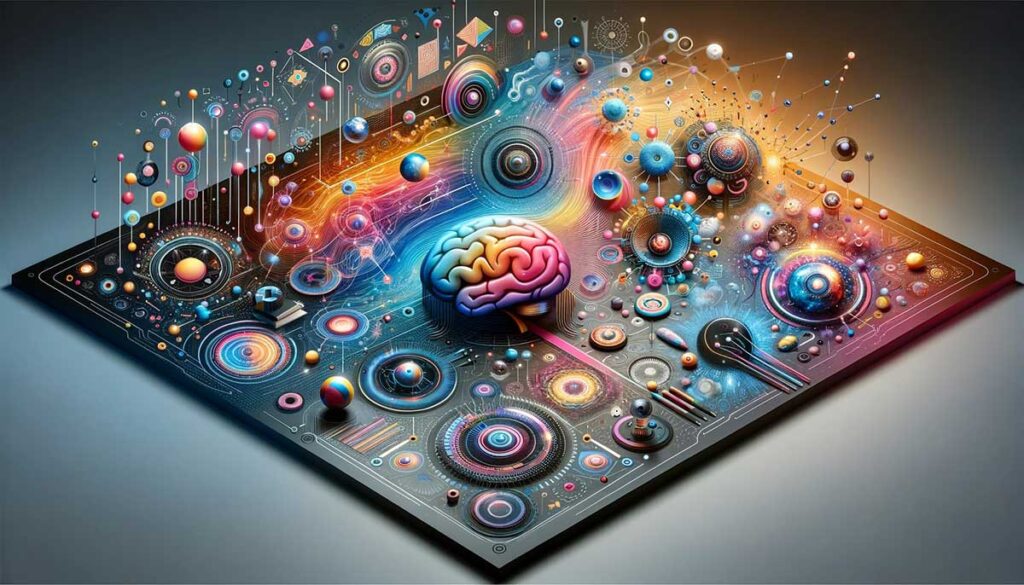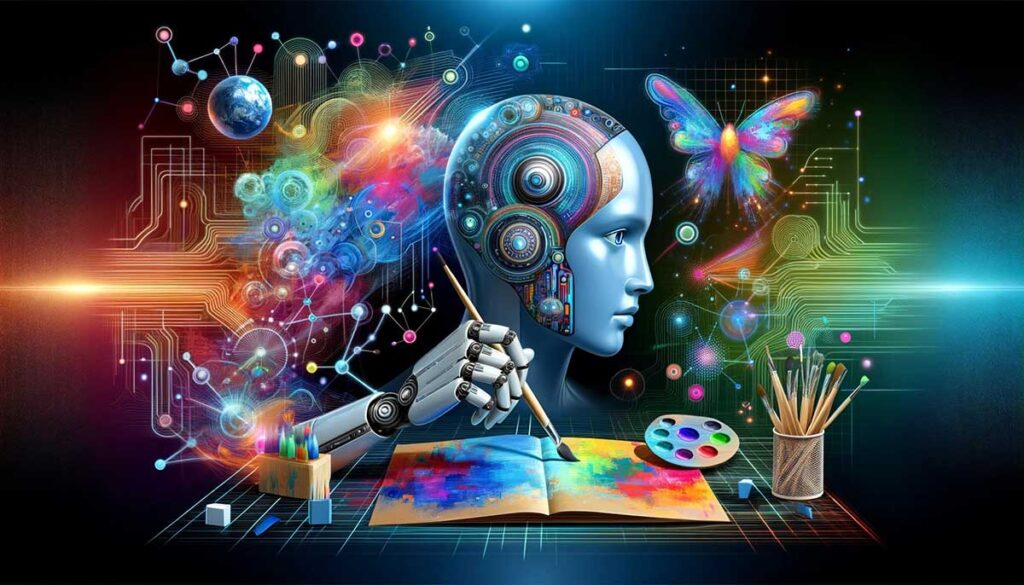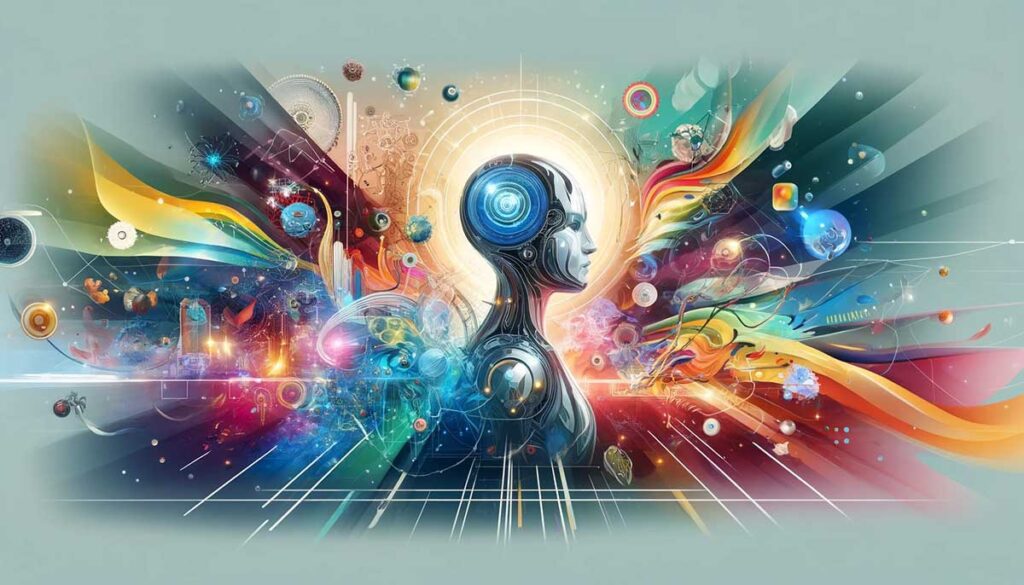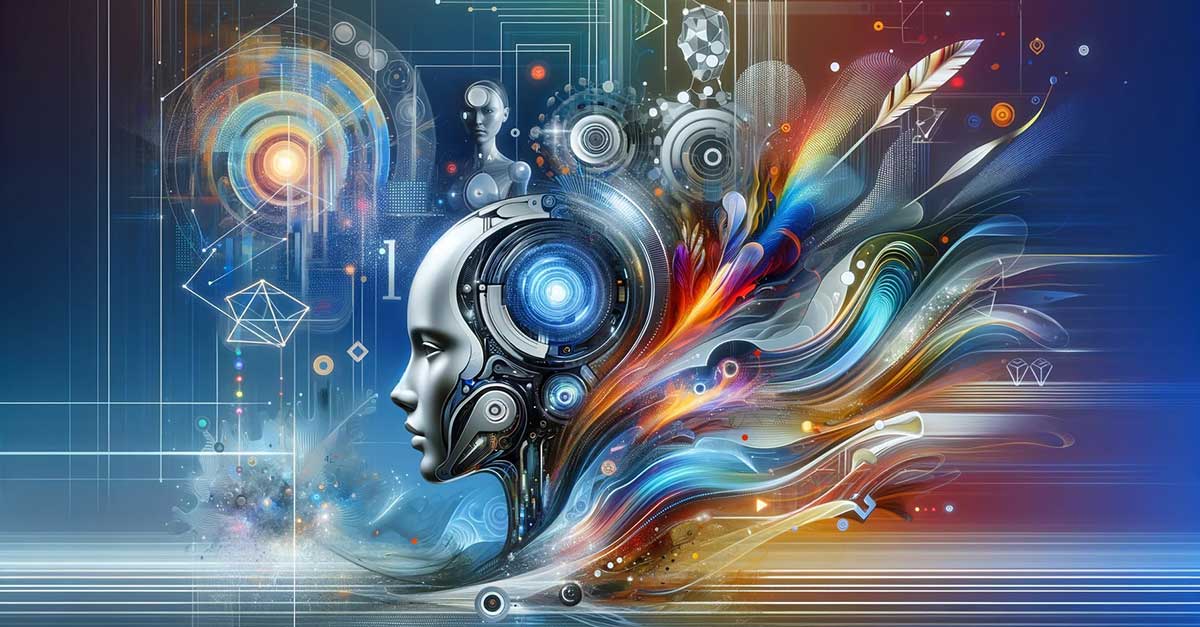Artificial Intelligence (AI) has rapidly permeated various fields, revolutionizing how we live and work. From automating mundane tasks to making groundbreaking discoveries, AI’s capabilities seem boundless. However, a compelling question arises: Can a machine ever be truly creative?
This article explores this question by delving into AI’s attempts to mimic human creativity, examining both the technologies behind AI-generated works and the philosophical and ethical implications. We will also highlight real-world applications and discuss the future of AI in creative domains.
Understanding Creativity and The Psychology Behind

Creativity, from a human perspective, involves the ability to generate original ideas, solve problems in novel ways, and express oneself through various mediums. It encompasses imagination, innovation, and emotional depth. Examples of human creativity include masterpieces like Leonardo da Vinci’s “Mona Lisa,” Beethoven’s symphonies, Shakespeare’s literary works, and groundbreaking innovations like the invention of the light bulb.
Psychological theories of creativity often focus on divergent thinking, where individuals generate multiple solutions to a problem. The role of the unconscious mind is also significant, as many creative insights occur during periods of rest or distraction. Diagrams and infographics can help illustrate the creative process, showing how inspiration, ideation, and execution interconnect to produce creative works.
How AI Attempts Creativity

AI algorithms are designed to mimic creative processes by analyzing vast amounts of data to generate new content. For example, neural networks can create paintings reminiscent of famous artists, AI composers can produce original music, and models like GPT-3 or GPT-4 can write coherent stories. These systems use patterns and structures from existing works to craft something new, often surprising experts with their outputs.
One notable example is the AI-generated painting “Portrait of Edmond de Belamy,” which was created by a generative adversarial network (GAN) and sold at Christie’s auction for $432,500. This painting, part of a series created by the French art collective Obvious, demonstrated that AI could produce artworks that resonate with human viewers.
In music, AI systems like OpenAI’s MuseNet and Google’s Magenta have composed original pieces that range from classical symphonies to contemporary pop songs. MuseNet, for instance, uses deep learning to compose music in various styles, blending elements from different genres and time periods to create unique compositions.
GPT-4, a language model developed by OpenAI, has shown remarkable capabilities in generating human-like text. It can write stories, poems, and articles that are often indistinguishable from those written by humans. This model learns from vast amounts of text data, enabling it to understand context, tone, and structure, which are crucial for creative writing.
Tools and Technologies for AI-generated artworks
The tools enabling AI creativity include neural networks, deep learning, and generative models. Neural networks simulate the human brain’s interconnected neuron structure, while deep learning allows these networks to learn from extensive datasets. These technologies underpin many creative AI applications, from generating realistic images to composing complex musical pieces.
Generative Adversarial Networks (GANs) are particularly notable for their creative potential. GANs consist of two neural networks—the generator and the discriminator—competing against each other. The generator creates new content, while the discriminator evaluates its authenticity. Through this adversarial process, GANs iteratively improve their outputs, producing highly realistic and creative results. For instance, DeepArt.io uses GANs to transform photographs into artworks in the style of famous painters.
Another essential tool is the Recurrent Neural Network (RNN), which is effective in tasks involving sequential data, such as music and language. RNNs have been used in projects like Google’s Magenta, where they help generate melodies and harmonies that evolve over time, mimicking human compositional techniques.
Transformer models, like GPT-4, have revolutionized natural language processing by understanding and generating human-like text. These models rely on self-attention mechanisms to process and generate text, making them incredibly versatile for creative writing tasks.
Data on the success and reception of AI-created works show increasing acceptance and success, with many pieces being showcased in galleries and concerts. For example, AI-generated music has been performed by professional orchestras, and AI-written articles have been published in reputable journals. These achievements indicate that AI’s role in creative fields is not just a novelty but a burgeoning area of genuine innovation and artistic exploration.
Visuals accompanying this section can include examples of AI-generated artworks, music scores, and snippets of AI-written text, providing a tangible sense of AI’s creative capabilities. This helps readers visualize the intersection of AI and creativity and appreciate the technological advancements driving this new frontier.
The Debate: Can AI Be Truly Creative?

Arguments for AI Creativity
Proponents of AI creativity argue that AI systems can be considered genuinely creative because they generate novel and useful content, which are key components of creativity. They point to instances where AI has not only matched but occasionally surpassed human expectations in creative fields. For example, AI-generated paintings have been auctioned at prestigious art houses, and AI-composed music has moved audiences with its emotional depth.
One compelling argument is the capability of AI to generate unexpected and innovative outputs. AI-generated art, such as the “Portrait of Edmond de Belamy,” has fetched high prices at auction, indicating that AI’s creative outputs can possess value and originality recognized by the art world. In music, AI systems like AIVA (Artificial Intelligence Virtual Artist) have composed original scores used in films and advertisements, demonstrating AI’s ability to create compelling and contextually appropriate music.
Additionally, AI’s ability to analyze vast datasets allows it to create works that blend styles and elements in novel ways, often producing hybrid forms that human creators might not conceive. For example, AI has been used to generate new recipes by combining ingredients and techniques from different cuisines, resulting in innovative culinary creations. These examples suggest that AI can indeed perform creative acts by producing novel and valuable outputs, thus challenging traditional notions of creativity.
Arguments Against AI Creativity
Critics of AI creativity maintain that true creativity requires consciousness, emotions, and personal experience—qualities that AI inherently lacks. They argue that while AI can mimic creative processes and produce impressive outputs, it does so without understanding or intentionality. AI-generated works, in this view, are mere reflections of the data and algorithms they are built on, lacking the depth and intent that characterize human creativity.
One major limitation is AI’s reliance on existing data. AI models learn and generate content based on patterns found in the data they are trained on, which means they cannot create anything genuinely original that transcends their programming. Critics argue that this process is fundamentally different from human creativity, which involves not only recombination of existing knowledge but also the introduction of new, subjective experiences and emotional insights.
Furthermore, AI lacks the capacity for self-reflection and emotional resonance. Human creativity is often driven by personal experiences, emotions, and the desire to communicate something meaningful. For example, a poem written by a human can convey deep personal feelings and experiences, whereas an AI-generated poem lacks this subjective depth. Critics argue that this lack of personal connection means AI cannot truly understand or replicate the essence of human creativity.
Human-AI Collaboration
Many believe that AI should not be viewed as a competitor to human creativity but rather as a powerful collaborator. AI can enhance human creativity by providing new tools and perspectives, allowing artists, musicians, and writers to explore new styles and techniques that might otherwise be inaccessible.
For instance, AI can assist in generating preliminary drafts, which human creators can then refine and build upon. This collaborative approach can lead to innovative works that combine the strengths of both human intuition and machine precision. Musicians like Taryn Southern have used AI tools to co-create songs, leveraging AI to generate melodies and harmonies that she then arranges and produces, resulting in a unique fusion of human and machine creativity.
In visual arts, artists like Mario Klingemann use AI as a creative partner, employing generative models to produce artworks that push the boundaries of traditional artistic practices. These collaborations showcase the potential for AI to augment and expand human creative capabilities, leading to new forms of artistic expression.
Moreover, AI can serve as a source of inspiration, generating ideas and concepts that human creators might not have considered. By exploring vast datasets and identifying patterns, AI can suggest novel combinations and variations, sparking new creative directions. For example, writers can use AI to brainstorm plot ideas or character development, while designers can use AI-generated prototypes as a starting point for their projects.
The debate over AI’s ability to be truly creative is multifaceted, involving technical, philosophical, and practical considerations. While AI may not possess the consciousness and emotional depth that characterize human creativity, its ability to generate novel and valuable content, collaborate with human creators, and inspire new ideas suggests that it has a significant role to play in the future of creative endeavors. This collaborative potential underscores the importance of viewing AI not as a threat to human creativity but as a complementary tool that can enhance and expand our creative horizons.
Ethical and Philosophical Considerations with AI-generated works

Ethical Implications
AI creativity raises numerous ethical concerns, particularly in the realms of copyright, authorship, and the potential devaluation of human creativity. As AI-generated works become more prevalent, the question of who owns these creations becomes increasingly complex. Traditional copyright laws were designed with human creators in mind, and applying these laws to AI-generated works poses significant challenges.
One primary ethical issue is attributing authorship. Since AI lacks consciousness and intent, it cannot be considered an author in the traditional sense. This raises questions about who should hold the rights to AI-generated works—the developers of the AI, the users who input the data, or some combination of both? For instance, if an AI artist creates a painting, should the rights belong to the programmer who developed the AI, the person who selected and curated the data set, or the AI itself? Real-world cases, such as the sale of “Portrait of Edmond de Belamy,” have already prompted legal debates and highlighted the need for clearer guidelines.
Moreover, there is concern about the devaluation of human creativity. If AI can produce high-quality art, music, and literature at a fraction of the cost and time it takes for humans, there is a risk that human creators could be overshadowed or undervalued. This could lead to a reduction in opportunities and financial rewards for human artists, musicians, and writers. The balance between embracing AI advancements and protecting human creativity is delicate and requires careful consideration.
Another ethical consideration is the use of AI tools in creating works that may inadvertently infringe on existing copyrights. AI systems trained on large datasets that include copyrighted material could produce outputs that closely resemble those works, raising questions about plagiarism and intellectual property rights. Ensuring that AI-generated content respects existing copyrights and does not unfairly exploit the work of human creators is a critical ethical challenge.
Philosophical Questions
The rise of AI creativity also prompts deep philosophical questions about the nature of art, creativity, and consciousness. One of the central debates revolves around whether AI can truly be creative if it lacks consciousness and subjective experience. Creativity is often seen as an expression of personal insights, emotions, and experiences—qualities that AI, as a non-sentient entity, does not possess.
Philosophers and thought leaders offer diverse viewpoints on this issue. Some argue that creativity is not solely the domain of conscious beings; rather, it can be understood as the production of novel and valuable ideas, regardless of the source. From this perspective, AI-generated works can be considered creative because they introduce new and useful concepts into the world, even if they arise from algorithms rather than human imagination.
Others contend that true creativity requires a conscious mind capable of intentionality, self-reflection, and emotional depth. They argue that AI, which operates based on pre-programmed algorithms and data inputs, lacks the intrinsic qualities that define human creativity. For instance, a poem written by AI might mimic the structure and language of human poetry, but it does not stem from personal emotion or experience, which are essential components of human artistic expression.
The nature of art itself is also questioned in the context of AI. Art has traditionally been seen as a reflection of the human condition, a medium through which creators convey their inner worlds and engage with viewers on an emotional level. If AI can produce works that evoke similar responses, does this change our understanding of art? Some philosophers suggest that AI art challenges the notion of art as an exclusively human endeavor, expanding the boundaries of what can be considered artistic creation.
Additionally, there are questions about the role of the artist in the creative process. In collaborations between humans and AI, who is the true creator? Is it the human who guides and curates the AI’s output, or the AI that generates the content? These questions challenge traditional concepts of authorship and creativity, prompting a reevaluation of the relationship between humans and their tools.
The ethical and philosophical implications of AI creativity are vast and multifaceted. Addressing these issues requires a collaborative effort between technologists, artists, legal experts, and philosophers to develop frameworks that respect and protect human creativity while embracing the potential of AI to contribute to the creative process. As we navigate this evolving landscape, it is crucial to remain mindful of both the opportunities and challenges that AI brings to the world of creativity.
The Future of AI and Creativity

Advancements on the Horizon
Future developments in AI creativity promise to be even more transformative, with emerging technologies and ongoing research likely to enhance AI’s ability to generate sophisticated and contextually rich creative works. These advancements will open new avenues for exploration and innovation, pushing the boundaries of what is possible in various creative fields.
One area of significant progress is in the refinement of generative models, such as GANs (Generative Adversarial Networks) and transformers. These models are becoming increasingly adept at understanding and replicating complex patterns found in music, art, and literature. For instance, advancements in GANs could lead to AI-generated art that not only mimics human styles but also develops entirely new artistic movements, blending elements in ways humans might not consider.
In the realm of music, AI models like OpenAI’s Jukedeck and Google’s Magenta are continually improving, enabling the creation of more intricate and emotionally resonant compositions. Future AI composers may be able to understand and incorporate emotional cues, resulting in music that responds to and enhances the listener’s mood in real-time. Imagine personalized soundtracks that adapt to your activities, whether you’re working, exercising, or relaxing.
Literature is another domain ripe for AI innovation. As language models like GPT-4 and beyond become more sophisticated, they will likely produce increasingly complex and nuanced narratives. These models could assist authors by generating rich storylines, character developments, and dialogues, acting as a collaborative tool that enhances the storytelling process. Additionally, AI could play a role in creating interactive and adaptive narratives for video games and virtual reality experiences, providing users with immersive, personalized adventures.
Emerging technologies such as quantum computing also hold the potential to revolutionize AI creativity. Quantum computers could process and analyze data at unprecedented speeds, enabling AI systems to create more complex and detailed works of art, music, and literature. These advancements could lead to the development of AI that can not only mimic but also innovate, creating entirely new forms of creative expression.
Impact on Various Fields
AI’s influence on creative fields such as entertainment, design, and education is expected to grow, potentially revolutionizing how we create and consume content. Hypothetical scenarios and expert opinions suggest that AI could lead to the emergence of new genres and forms of expression, transforming the landscape of creative industries.
In the entertainment industry, AI is already being used to generate special effects, write scripts, and even create virtual actors. As AI technology advances, it could lead to fully AI-generated films and television shows, where every aspect—from scriptwriting to visual effects—is crafted by intelligent systems. This could result in a surge of content tailored to niche audiences, with AI analyzing viewer preferences to produce highly personalized entertainment experiences.
Design is another field where AI is making significant strides. AI-powered design tools can generate logo designs, create complex architectural plans, and even produce fashion collections. Future developments could see AI becoming an integral part of the design process, working alongside human designers to push the boundaries of creativity and efficiency. For example, AI could analyze market trends and consumer preferences to suggest innovative product designs that resonate with target audiences.
In education, AI has the potential to transform how creative skills are taught and developed. AI-driven educational tools can provide personalized learning experiences, adapting to the individual needs and learning styles of students. This could be particularly beneficial in creative disciplines, where traditional one-size-fits-all approaches often fall short. AI could offer real-time feedback on creative projects, suggest improvements, and even provide inspiration by showcasing diverse examples of creative work.
Moreover, AI could facilitate cross-disciplinary collaboration, bringing together experts from different fields to tackle complex creative challenges. For instance, AI systems could help scientists and artists collaborate on projects that explore the intersection of art and science, leading to innovative solutions and new forms of expression.
The integration of AI into creative fields also raises important questions about the future of work. As AI takes on more creative tasks, it could free human creators from routine and repetitive aspects of their work, allowing them to focus on higher-level, more conceptual aspects of creativity. However, this shift also requires a reevaluation of creative education and training, ensuring that future creators are equipped with the skills to work effectively alongside AI.
The future of AI and creativity holds immense promise, with advancements on the horizon that could revolutionize how we create, consume, and interact with creative content. As AI continues to evolve, it will play an increasingly significant role in shaping the future of various creative fields, offering new opportunities for innovation and collaboration while also posing challenges that require thoughtful consideration and adaptation.
Conclusions regarding AI Creativity
The question of whether a machine can be truly creative remains open. While AI has demonstrated remarkable capabilities in generating art, music, and literature, it still lacks the conscious experience that defines human creativity. However, the potential for AI to enhance and collaborate with human creativity is immense, suggesting a future where humans and machines co-create in ways previously unimaginable. As we navigate this evolving landscape, it is crucial to reflect on our views and consider the ethical and philosophical implications of AI’s role in creative fields.
AI Punter

